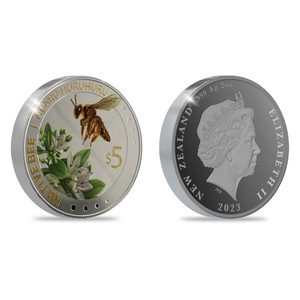The humble honey bee plays a crucial role in New Zealand's primary industry, and is responsible for much more than just honey production. This busy little creature was the focus of New Zealand Post's Honey Bees stamp issue.
Issue information
Honey bees have been kept in New Zealand for more than 150 years, and 2013 marked 100 years of the National Beekeepers' Association of New Zealand. In the years since bees were introduced to New Zealand, beekeeping has developed from a home craft to a progressive industry, and New Zealand is now recognised as one of the world's most advanced beekeeping countries.
The importance of horticulture and agriculture to New Zealand’s economy means that we may be more dependent on pollination from the honey bee than any other nation on Earth. Roughly one third of everything we eat is pollinated by bees, and many of our crops would not be viable without bee pollination.
Sadly honey bees in New Zealand are under threat as a result of the Varroa mite. This collectable stamp issue aimed to raise awareness of the role the honey bee plays in New Zealand, and tells the story of how the precious honey bee makes its honey.
Product Listing for Honey Bees
| Image | Title | Description | Price |
|---|---|---|---|
| Single Stamp |
Single 70c 'Collecting the nectar' gummed stamp. The first step in making honey is the gathering of nectar, which is normally done by ‘field bees’. The busy bees fly from flower to flower using their long tongues (proboscises) like straws to extract the nectar. Each bee stores the nectar in its ‘honey sac’, which can weigh almost as much as the bee itself when full. Within the honey sac, enzymes break down the complex sugars of the nectar into simpler sugars – a process known as ‘inversion’. |
$0.70 | |
| Single Stamp |
Single $1.40 'Returning to the hive' gummed stamp. Once the field bees’ honey sacs are full of nectar, the bees return to their hives. A single hive can contain thousands of bees, most of which are workers. When the field bees are back inside the hive, they place the honey into the cells closest to the entrance. Within each hive is a single queen bee, which goes out to mate with a drone (male) in the air and then returns to the hive where she lays eggs to produce more workers. |
$1.40 | |
| Single Stamp |
Single $1.90 'In the hive' gummed stamp. Inside the hive, the young worker ‘house bees’ transfer the nectar to the honey storage area of the hive. Enzymes are added to the nectar and the nectar is then further concentrated by house bees creating an air current inside the hive by fanning their wings to dry the nectar into honey. This process is called ‘ripening’. Once the honey has a water content less than 20 percent, the bees seal the cell of the honeycomb with a wax cap. |
$1.90 | |
| Single Stamp |
Single $2.40 'Harvesting the honey' gummed stamp. To harvest the honey, beekeepers remove the combs from the hives and spin them in centrifuges, or honey extractors. This process removes the honey from the combs and makes it relatively easy for the beekeepers to harvest the honey without damaging the hives or hurting the bees. Many beekeepers use veils and gloves to protect themselves during harvesting. Some also use bee smokers to mask a pheromone emitted by bees – making it less likely that the bees will become agitated as the beekeepers work. |
$2.40 | |
| Single Stamp |
Single $2.90 'Ready to eat' gummed stamp. Once harvested, the honey is processed and packaged into the jars and pottles we see on supermarket shelves. New Zealand honey products are sought after worldwide, and of the 9,000 to 12,000 tonnes of honey that are produced annually, one-third to half is exported. Honey is increasingly differentiated according to the flower source, and New Zealand is known around the world for its premium natural honey, particularly manuka honey, which is renowned for its antiseptic properties. |
$2.90 | |
| Miniature Sheet | Mint, used or cancelled gummed miniature sheet. | $9.30 | |
| First Day Cover | First day cover with five gummed stamps affixed. | $9.80 | |
| Miniature Sheet First Day Cover | First day cover with gummed miniature sheet affixed. | $9.80 | |
| Presentation Pack | The comprehensive collectable in the Honey Bees stamp issue was the presentation pack which contained the full set of stamps, the miniature sheet and the first day cover. Written by Roger Bray of the National Beekeeper's Association of New Zealand, it provided insights into beekeeping in New Zealand. | $29.90 |
Technical information
| Date of issue: | 3 July 2013 |
|---|---|
| Number of stamps: | Five gummed stamps |
| Denominations: | 70c, $1.40, $1.90, $2.40, $2.90 |
| Stamps, miniature sheet, first day covers and presentation pack designed by: | Strategy Design and Advertising, Wellington, New Zealand |
| Printer and process: | Southern Colour Print Ltd by offset lithography |
| Number of colours: | Four process colours |
| Stamp size and format: | 40mm x 30mm (horizontal) |
| Paper type: | 104gsm red phosphor gummed stamp paper |
| Number of stamps per sheet: | 25 |
| Perforation gauge: | 13.25 x 13 |
| Special blocks: | Plate/imprint blocks could be obtained by purchasing at least six stamps from a sheet. Barcode blocks were available in A and B formats. |
| Period of sale: | These stamps remained on sale until 2 July 2014. |



